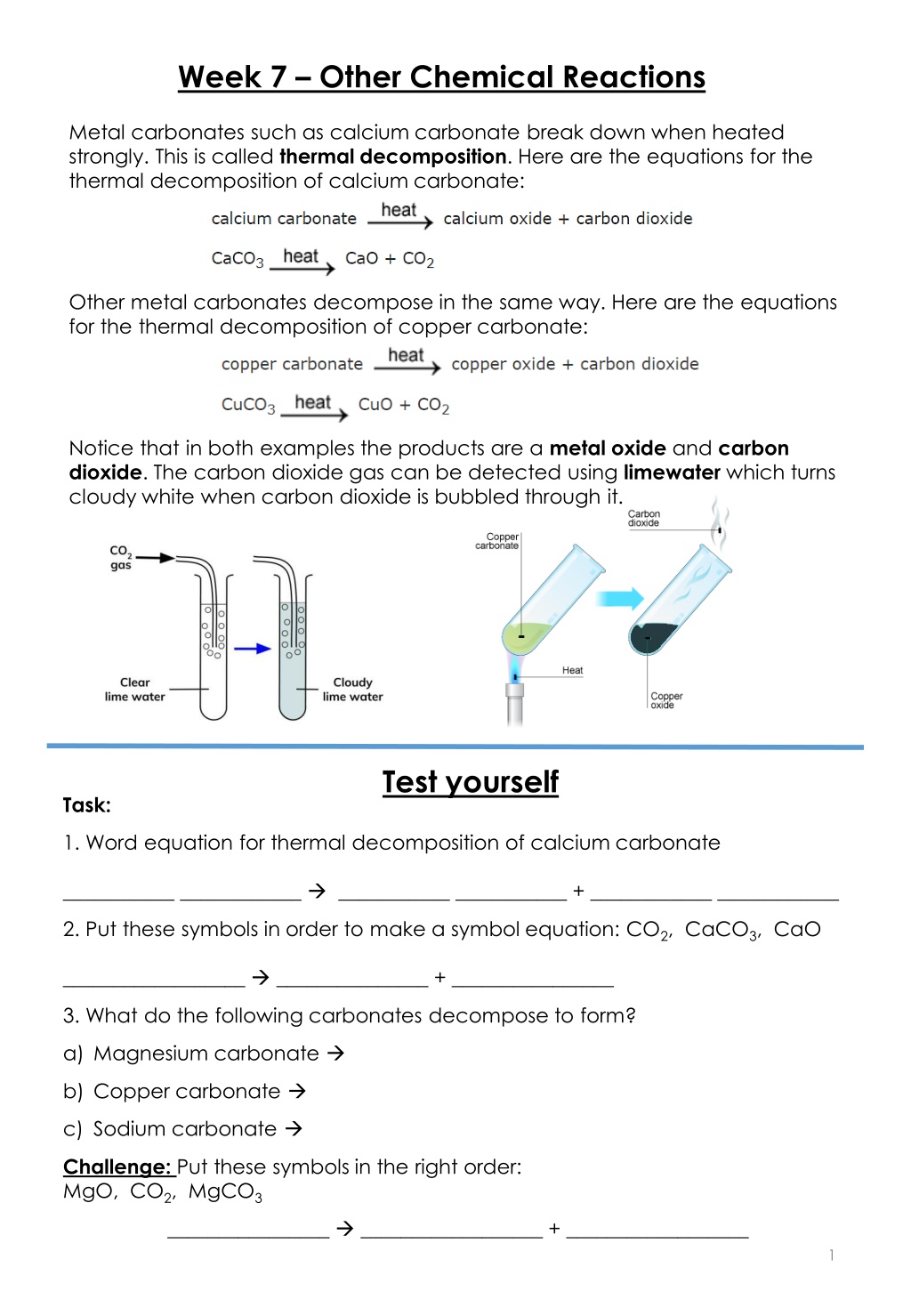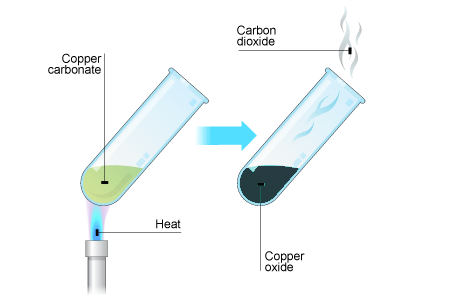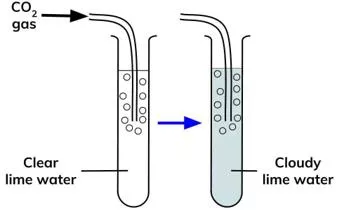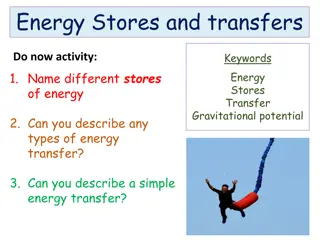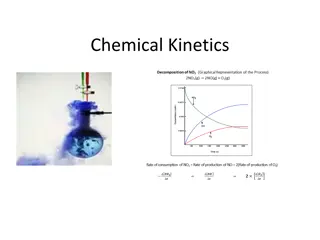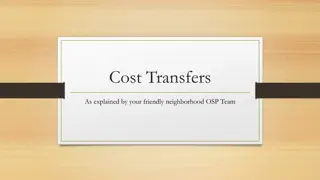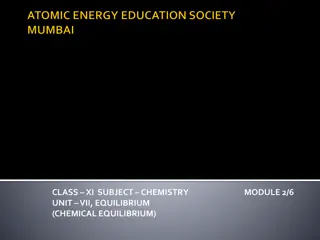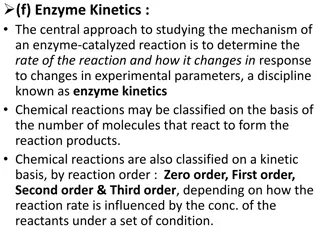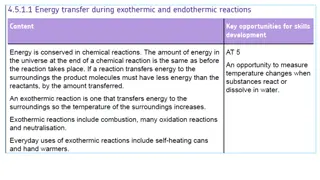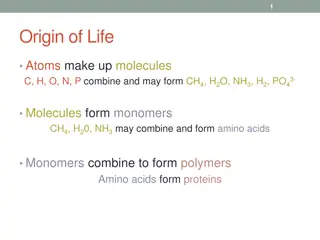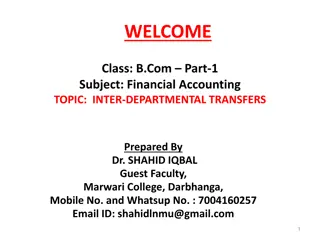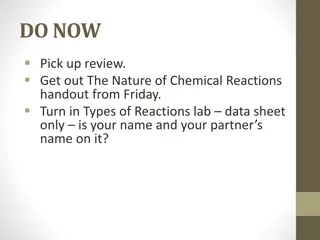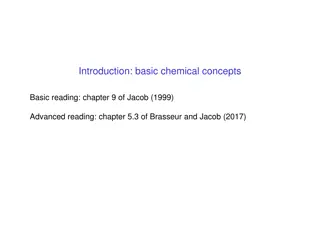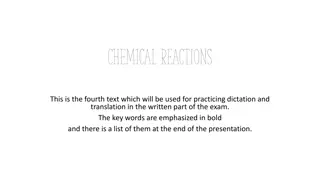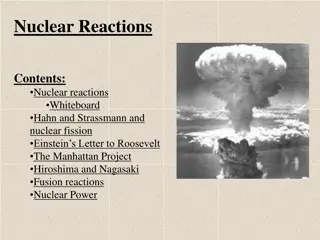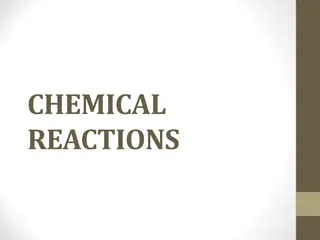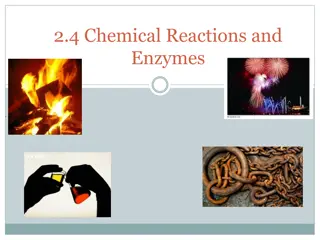Chemical Reactions and Energy Transfers
Understanding chemical reactions involving thermal decomposition of metal carbonates, identifying exothermic and endothermic reactions based on energy transfers, and recognizing oxidation and reduction in redox reactions.
Download Presentation

Please find below an Image/Link to download the presentation.
The content on the website is provided AS IS for your information and personal use only. It may not be sold, licensed, or shared on other websites without obtaining consent from the author.If you encounter any issues during the download, it is possible that the publisher has removed the file from their server.
You are allowed to download the files provided on this website for personal or commercial use, subject to the condition that they are used lawfully. All files are the property of their respective owners.
The content on the website is provided AS IS for your information and personal use only. It may not be sold, licensed, or shared on other websites without obtaining consent from the author.
E N D
Presentation Transcript
Week 7 Other Chemical Reactions Metal carbonates such as calcium carbonate break down when heated strongly. This is called thermal decomposition. Here are the equations for the thermal decomposition of calcium carbonate: Other metal carbonates decompose in the same way. Here are the equations for the thermal decomposition of copper carbonate: Notice that in both examples the products are a metal oxide and carbon dioxide. The carbon dioxide gas can be detected using limewater which turns cloudy white when carbon dioxide is bubbled through it. Test yourself Task: 1. Word equation for thermal decomposition of calcium carbonate ___________ ____________ ___________ ___________ + ____________ ____________ 2. Put these symbols in order to make a symbol equation: CO2, CaCO3, CaO __________________ _______________ + ________________ 3. What do the following carbonates decompose to form? a) Magnesium carbonate b) Copper carbonate c) Sodium carbonate Challenge: Put these symbols in the right order: MgO, CO2, MgCO3 ________________ __________________ + __________________ 1
Energy Transfers Exothermic and endothermic reactions Exothermic reactions These are reactions that transfer energy to the surroundings. The energy is usually transferred as heat energy, causing the reaction mixture and its surroundings to become hotter. The temperature increase can be detected using a thermometer. Some examples of exothermic reactions are: burning neutralisation reactions between acids and alkalis the reaction between water and calcium oxide Endothermic reactions These are reactions that take in energy from the surroundings. The energy is usually transferred as heat energy, causing the reaction mixture and its surroundings to get colder. The temperature decrease can also be detected using a thermometer. Some examples of endothermic reactions are: the reaction between ethanoic acid and sodium carbonate the thermal decomposition of calcium carbonate 2
Test yourself Task 1: Complete the sentences using the key words below When chemical reactions occur, energy is __________________ to or from the surroundings. An exothermic reaction is one that transfers energy to the surroundings so the temperature of the surroundings __________________. These include combustion, many oxidation reactions and _______________________. Some everyday uses of exothermic reactions are self-heating cans and hand warmers. An endothermic reaction is one that ________________ in energy from the surroundings so the temperature of the surroundings _______________________. Endothermic reactions include ___________________ _________________________ and the reaction of citric acid and sodium hydrogen carbonate. Some sports injury packs are based on endothermic reactions. Takes Increase Thermal decomposition Neutralisation Decrease Transferred Task 2: Underneath each picture, write down whether it is showing an exothermic or endothermic reaction. 1. 2. 3. 4. 3
Week 7 Other Chemical Reactions Higher Redox reactions In terms of oxygen in a chemical reaction: oxidation is the gain of oxygen reduction is the loss of oxygen For example, magnesium reacts with copper(II) oxide: magnesium + copper(II) oxide magnesium oxide + copper In this reaction: magnesium is oxidised to form magnesium oxide copper(II) oxide is reduced to form copper This is an example of a redox reaction because reduction and oxygen happen at the same time. Oxidation The following are some more examples of oxidation reactions: Metals Metals react with oxygen in the air to produce metal oxides. For example, magnesium reacts with oxygen to produce magnesium oxide when it is heated in air: magnesium + oxygen magnesium oxide 2Mg + O2 2MgO Non-metals Non-metals react with oxygen in the air to produce non-metal oxides. Here are two examples for the non-metals carbon and sulphur. Carbon reacts with oxygen to form carbon dioxide: carbon + oxygen carbon dioxide C + O2 CO2 Sulphur burns reacts with oxygen to form sulphur dioxide: sulphur + oxygen sulphur dioxide S + O2 SO2 4
Test yourself Task 1: Complete the following sentences. 1. ______________________ is the loss of oxygen. 2. ______________________ is the gain of oxygen. 3. A __________________ reaction is when both oxidation and reduction are happening at the same time. Task 2: State which substance is being oxidised and which one is being reduced in the following redox reactions. 1. magnesium + copper(II) oxide magnesium oxide + copper Example: Oxidised: Magnesium Reduced: Copper oxide 2. Potassium + iron oxide potassium oxide + iron Oxidised: Reduced: 3. Sodium + zinc oxide sodium oxide + zinc Oxidised: Reduced: 4. Copper oxide + zinc zinc oxide + copper Oxidised: Reduced: 5. Calcium + carbon dioxide calcium oxide + carbon Oxidised: Reduced: 5
